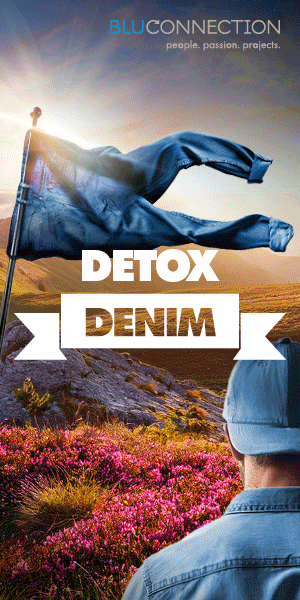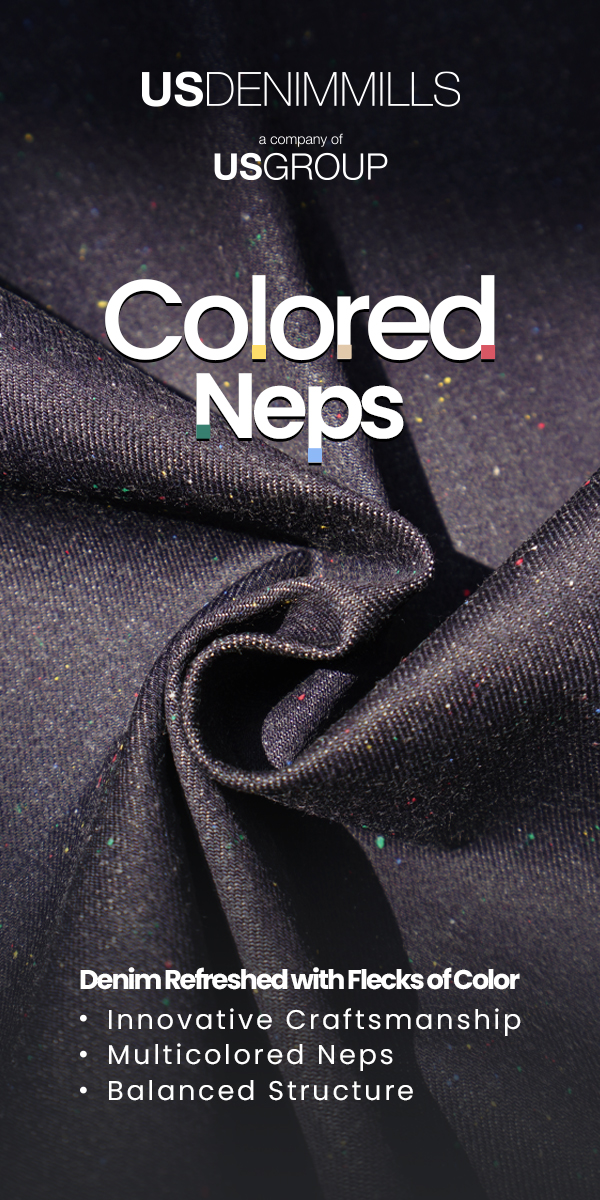New thinking about dyeing

In their quest to reduce the impacts of their products, brands and retailers are quick to promote a switch to more sustainable fibres. But indigo dyeing is a major industry hotspot that makes headlines when rivers turn blue. Behind the scenes, and beyond the scope of an average consumer’s line of vision, mills are rethinking their approach to dyeing to save resources at all stages of denim manufacturing.
The spectacular sight of rope or slasher dyeing is one of the many wonders in the world of indigo. But much is not often seen, nor often shown. At the front end, the measures taken to ensure safe working conditions and the handling of chemicals. At the back end, the infrastructure and complex array of processes needed to decontaminate dyehouse effluent.
The shift to pre-reduced indigo, instead of powder, is underway and a first key step that significantly contributes to reducing the use of hydrosulfite in dyeing. This reducing agent is said to generate some 90,000 tonnes of salt formation every year. By any measure, this mass, if it were to be released into natural water supplies, would degrade ecosystems. To address the issue of difficult-to-treat effluent, dyestuff makers such as DyStar, Archroma and BluConnection naturally recommend switching to their pre-reduced indigo formulations.
Salt-free solutions
DyStar, which is celebrating the 125th anniversary of the invention of synthetic indigo this year, continues to operate the original plant in Ludwigshafen, Germany, where the molecule was first synthetised. Its modern-day successor, Cadira Denim, replaces hydrosulfite with Sera Con C-RDA. “It is an organic reducing agent that is biologically degradable and easier to treat in an effluent treatment plant (ETP),” says Günther Widler, DyStar’s head of technology for denim.
Progress is also being made by the company to filter dyebaths to retrieve the indigo and obtain clean, salt-free water. “This will make a denim dyeing range work in a closed loop, no indigo will go to an ETP and freshwater consumption can be reduced by up to 80%,” he says.
BluConnection’s new, plant-based reducing agent BluWit also eliminates the need for hydrosulfite in dyeing processes with pre-reduced indigo. “It is a natural, more sustainable and safer alternative to hydrosulfite. It is odourless, biodegradable, and easy to handle,” says BluConnection’s CEO and founder Peter Zinser. In production trials conducted at denim mills, the use of BluWit as a reducing agent has been found to lead to 95% sulfite-free effluent, having 60% less salt, and reducing chemical oxygen demand (COD) by 5%. In wastewater, total dissolved solids (TDS) can be brought down by up to 61%, the company has found.
In addition to contributing to safer dyeing conditions, BluWit is also said to provide the authentic denim look that the industry expects. Tests at denim mills have shown that combining the company’s DenimBlu30 with BluWit is a no compromise solution. “After processing, jeans present a bright shade and fresh tone,” says Mr Zinser.
Emulating indigo
A bright blue hue is what Pakistani denim supplier Crescent Bahümán (CBL) feels it has achieved with Blue Infinity. This new, low-impact denim warp dyeing process does not use indigo, making hydrosulfite unnecessary. “Using indigo as a dyestuff has been under pressure because of high water consumption, the use of hydrosulfite as a reducing agent and aniline content,” says Zaki Saleemi, CBL’s vice president of strategy. “CBL worked not only to address these underlying processing issues but has also sought to reach a wider scope of shades and effects from brilliant blues to greener and greyer shades,” he says. Blue Infinity “gives a flexibility in design that product developers will appreciate,” he adds, and a product will age like any indigo denim.
Applied in a compact dyeing range, Blue Infinity makes it possible to decrease the number of dye boxes, which, along with being aniline-free, helps reduce total volumes of water, dyestuff and auxiliaries, he says. They are said to lead to savings in the order of 50% for water and chemicals and 45% for energy. The GOTS 6.0-approved chemistry creates safer working conditions, he adds, as “more than 99% of the chemicals used in the dyeing process have no hazardous character and have a biodegradable profile.”
Pakistan-based mill Azgard 9 has also introduced a salt-free dyeing method that is said to save chemicals and water without compromising performance. “Ambiclear generates effluent that is neutral in chemicals and colour and is 50% less polluted than that of conventional processes,” says Mian Farrukh Mehmood, head of product development. “Conventional dyeing requires 20 to 25 litres of water per metre of fabric; we have brought this down to 7 litres/metre, reducing water usage by 75%.”
Anticipating fading
If handled correctly, indigo dyeing can be safe and clean, and purists uphold that a pair of raw denim jeans worn for years is a very sustainable product. This may well be true but may well be immaterial. Washed and faded is the norm. This market reality has pushed mills to rethinking their dyeing processes to minimise downstream impacts at laundries. The new thinking starts with a simple assumption: what if one were to apply less indigo, and its accompanying auxiliaries, to create less intense hues that would wash down faster and may be more laser-friendly?
This is precisely how Evlox devised its ICE dyeing concept. “It seems quite logical and simple, but sometimes logic and technology do not go hand in hand, and developing this process has been a challenge,” Paco Ortega, R&D manager at Spain-based Evlox tells Inside Denim. He says the company combined different characteristics, “both physical and chemical, which results in a low penetration and hues reminiscent of 1980s denims”. It also eliminates or reduces the quantities of hydrosulfite and caustic soda, he states.
Using Jeanologia’s Environmental Impact Measuring (EIM) scoring system, Evlox’s ICE dyed denims were found to save up to 80% in chemicals, up to 65% in water and up to 25% in energy when aiming for lighter washes, when compared with a dark indigo fabric having the same structure.
Several mills offer solutions that lessen dye penetration to speed up fading, make denims laser-friendly, and save water, chemicals and energy. Many are based on a pretreatment applied to the yarn to limit absorption, such as Indigo Textile’s Orbit Dyeing Technology. “In traditional dyeing, 40% of the indigo penetrates yarn so more processing is needed to whiten a product. This is a fundamental rethink of dyeing methods,” says Nauman Ahmad, product development manager for the Pakistani mill. With Orbit, a fabric’s EIM score is improved by approximately 25%, he adds.
With Cascara, “dye penetrates just two-thirds of a yarn,” says Noman Nadir Khan, VP research & product development for Soorty. This Pakistan mill has also invested in a Smart Indigo machine, an electrochemical reduction process, which reportedly saves up to 71% water and 22% steam.
At Arvind, in India, indigo is oxidised in near waterless conditions using its Quantum foam dyeing process which takes place in a nitrogen chamber. “Arvind is one of the few companies in the world to have this type of machine,” says senior marketing manager Ashutosh Bhargava. Denims dyed using this method are highly compatible with laser finishing, he adds, and thus avoid the hazardous chemicals (PP, bleach, etc.) used in conventional laundering processes.
Two years ago, the company began using CleanKore’s patented technology that makes indigo bond only to the outer surface of a yarn. “It saves significant amounts of water, chemicals, energy and speeds up process times, at both fabric and garment manufacturing stages,” says Mr Bhargava. “It is a good solution for brands looking to move towards waterless laser finishing.”
The newest company to adopt CleanKore technology is the Hong Kong-based vertical denim manufacturer Epic Group. “Using verified, third-party data, Epic has calculated up to 44% water savings in garment finishing and up to 60% energy savings in the fabric dyeing stage,” Ryan Ripley, CleanKore business development manager tells Inside Denim. He adds that Epic has committed to converting 15-20 million garments to its technology in the next three years.
Going waterless
Cleaner dyeing processes initially developed for knitwear, where the use of indigo can be problematical, could be viable solutions for woven denim fabrics as well. Colourizd, with offices in Hong Kong and North Carolina, has devised what it calls a ‘direct colour application method’ for cellulosic fibres. The new twist of this technology is that it generates a washed down effect at yarn stage, and thus potentially eliminates the need for washing and fading down the line.
Company founders Antony Lau, Jennifer and Alan Thompson were looking to give cotton fabrics a linen-like look when they began working on this process 12 years ago, and which they commercialise under the name GiDélavé. Now they say that technical progress makes it possible to emulate denim.
The process that Colourizd has created transfers a colourant to a pretreated yarn, which can be grey and does not need to be bleached, removing one manufacturing step. “Unlike conventional dyeing that leads to loss of strength, our method adds strength to yarns,” says Ms Thompson. “A 20 singles comes out as a 19 singles.” This is not only “a savings point” it can also be useful to reinforce yarns made from recycled cotton, she claims.
Tests using indigo as a colourant are underway at Colourizd. “There are two ways we could oxidise the indigo,” explains Mr Thompson. “We could either oxidise the indigo prior to using it or treat the yarn as it comes through the machine and then chemically oxidise the indigo.” With regards to common washing and fading techniques, he says that “enzyme washes, pumice and whiskers give good results”. But laser treatments will not work the same way, he notes, as “our machine forces colour into the yarn” whereas conventional dyeing keeps the core white. Another element to take into account, says Ms Thompson, is that “the indigo will not fade. This requires designers to think ahead on what shade and fade they want as they won’t be able to adjust the colour in finishing.”
Confident that their invention can help make garment manufacturing more sustainable, and can be particularly advantageous for dyehouses located in water-stressed regions, they founded a new company, Colourizd Machinery Company, to commercialise the equipment. “Our current machine is industrial scale and can produce 450,000 yards a month,” they say. Two machines are currently running in China.
Thesara Industrial Technology, based in India, is finalising another near-waterless dyeing process it calls Wisik that applies indigo in a “reduced atmosphere” on a fabric, not a yarn. “It is a surface dyeing,” V. Prabhakaran Chetti tells Inside Denim. He adds that “it is safe and does not emit any harmful gases.”
By eliminating yarn dyeing, Mr Chetti says no sizing is needed which, among other benefits of this solution, leads to decreased water and chemicals usage, shorter processing times, and thus overall energy savings and lower production costs. Initially developed for knits, the technique is said to also apply to woven fabrics. As it is a surface dyeing process (+ surface), it colours a single side of the fabric at a time, with up to 80% penetration. “But it is possible to achieve the authentic white core of traditional indigo yarn-dyed fabrics,” he says.
Thesara now has a working model of the equipment and is close to finalising a commercial version. “We are looking to partner with a machine manufacturing company to make it available globally for the denim community,” he says.
As pressure mounts to save precious water and energy supplies, indigo dyeing is, as can be seen, the focus of great experimentation and innovation. They are a sign of the efforts suppliers and mills are making to ensure safer working conditions, make the best use of resources, and accelerate the shift towards more sustainable manufacturing. They do, however, require new thinking in the design and product development processes. This is the missing link that will fundamentally make the most difference and would lead to real change.
Soorty’s Cascara dyeing process is said to reduce the amount of water used as well as the load on effluent, without compromising aesthetics.
Photo: SOORTY













